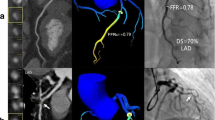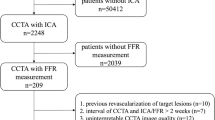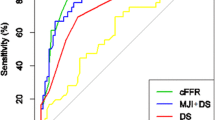Abstract
Objective
To investigate the effect of coronary calcification morphology and severity on the diagnostic performance of machine learning (ML)–based coronary CT angiography (CCTA)–derived fractional flow reserve (CT-FFR) with FFR as a reference standard.
Methods
A total of 442 patients (61.2 ± 9.1 years, 70% men) with 544 vessels who underwent CCTA, ML-based CT-FFR, and invasive FFR from China multicenter CT-FFR study were enrolled. The effect of calcification arc, calcification remodeling index (CRI), and Agatston score (AS) on the diagnostic performance of CT-FFR was investigated. CT-FFR ≤ 0.80 and lumen reduction ≥ 50% determined by CCTA were identified as vessel-specific ischemia with invasive FFR as a reference standard.
Results
Compared with invasive FFR, ML-based CT-FFR yielded an overall sensitivity of 0.84, specificity of 0.94, and accuracy of 0.90 in a total of 344 calcification lesions. There was no statistical difference in diagnostic accuracy, sensitivity, or specificity of CT-FFR across different calcification arc, CRI, or AS levels. CT-FFR exhibited improved discrimination of ischemia compared with CCTA alone in lesions with mild-to-moderate calcification (AUC, 0.89 vs. 0.69, p < 0.001) and lesions with CRI ≥ 1 (AUC, 0.89 vs. 0.71, p < 0.001). The diagnostic accuracy and specificity of CT-FFR were higher than CCTA alone in patients and vessels with mid (100 to 299) or high (≥ 300) AS.
Conclusion
Coronary calcification morphology and severity did not influence diagnostic performance of CT-FFR in ischemia detection, and CT-FFR showed marked improved discrimination of ischemia compared with CCTA alone in the setting of calcification.
Key Points
• CT-FFR provides superior diagnostic performance than CCTA alone regardless of coronary calcification.
• No significant differences in the diagnostic performance of CT-FFR were observed in coronary arteries with different coronary calcification arcs and calcified remodeling indexes.
• No significant differences in the diagnostic accuracy of CT-FFR were observed in coronary arteries with different coronary calcification score levels.






Similar content being viewed by others
Abbreviations
- AS:
-
Agatston score
- CAD:
-
Coronary artery disease
- CCTA:
-
Coronary CT angiography
- CRI:
-
Calcification remodeling index
- CT-FFR:
-
Coronary CT angiography–derived fractional flow reserve
- FFR:
-
Fractional flow reserve
- ICA:
-
Invasive coronary angiography
- ML:
-
Machine learning
References
Chao SP, Law WY, Kuo CJ et al (2010) The diagnostic accuracy of 256-row computed tomographic angiography compared with invasive coronary angiography in patients with suspected coronary artery disease. Eur Heart J 31:1916–1923
Miller JM, Rochitte CE, Dewey M et al (2008) Diagnostic performance of coronary angiography by 64-row CT. N Engl J Med 359:2324–2336
Meijboom WB, Van Mieghem CA, van Pelt N et al (2008) Comprehensive assessment of coronary artery stenoses: computed tomography coronary angiography versus conventional coronary angiography and correlation with fractional flow reserve in patients with stable angina. J Am Coll Cardiol 52:636–643
Chen CC, Chen CC, Hsieh IC et al (2011) The effect of calcification score on the diagnostic accuracy of coronary computed tomography angiography. Int J Cardiovasc Imaging 27:37–42
Vavere AL, Arbab-Zadeh A, Rochitte CE et al (2011) Coronary artery stenoses: accuracy of 64-detector row CT angiography in segments with mild, moderate, or severe calcification--a subanalysis of the CORE-64 trial. Radiology 261:100–108
Kruk M, Noll D, Achenbach S et al (2014) Impact of coronary artery calcification characteristics on accuracy of CT angiography. JACC Cardiovasc Imaging 7:49–58
Xaplanteris P, Fournier S, Pijls NH et al (2018) Five-year outcomes with PCI guided by fractional flow reserve. N Engl J Med 379:250–259
Zimmermann FM, Ferrara A, Johnson NP et al (2015) Deferral vs. performance of percutaneous coronary intervention of functionally non-significant coronary stenosis: 15-year follow-up of the DEFER trial. Eur Heart J 36:3182–3188
Zhuang B, Wang S, Zhao S, Lu M (2020) Computed tomography angiography-derived fractional flow reserve (CT-FFR) for the detection of myocardial ischemia with invasive fractional flow reserve as reference: systematic review and meta-analysis. Eur Radiol 30:712–725
von Knebel Doeberitz PL, De Cecco CN, Schoepf UJ et al (2019) Coronary CT angiography-derived plaque quantification with artificial intelligence CT fractional flow reserve for the identification of lesion-specific ischemia. Eur Radiol 29:2378–2387
Min JK, Leipsic J, Pencina MJ et al (2012) Diagnostic accuracy of fractional flow reserve from anatomic CT angiography. JAMA 308:1237–1245
Nørgaard BL, Leipsic J, Gaur S et al (2014) Diagnostic performance of noninvasive fractional flow reserve derived from coronary computed tomography angiography in suspected coronary artery disease: the NXT trial (Analysis of Coronary Blood Flow Using CT Angiography: Next Steps). J Am Coll Cardiol 63:1145–1155
Douglas PS, Pontone G, Hlatky MA et al (2015) Clinical outcomes of fractional flow reserve by computed tomographic angiography-guided diagnostic strategies vs. usual care in patients with suspected coronary artery disease: the prospective longitudinal trial of FFR(CT): outcome and resource impacts study. Eur Heart J 36:3359–3367
Fairbairn TA, Nieman K, Akasaka T et al (2018) Real-world clinical utility and impact on clinical decision-making of coronary computed tomography angiography-derived fractional flow reserve: lessons from the ADVANCE registry. Eur Heart J 39:3701–3711
Patel MR, Nørgaard BL, Fairbairn TA et al (2020) 1-Year impact on medical practice and clinical outcomes of FFRCT: the ADVANCE registry. JACC Cardiovasc Imaging 13:97–105
Andreini D, Modolo R, Katagiri Y et al (2019) Impact of fractional flow reserve derived from coronary computed tomography angiography on heart team treatment decision-making in patients with multivessel coronary artery disease: Insights from the SYNTAX III REVOLUTION trial. Circ Cardiovasc Interv 12:e007607
Coenen A, Kim YH, Kruk M et al (2018) Diagnostic accuracy of a machine-learning approach to coronary computed tomographic angiography-based fractional flow reserve: Result from the MACHINE consortium. Circ Cardiovasc Imaging 11:e007217
Nørgaard BL, Gaur S, Leipsic J et al (2015) Influence of coronary calcification on the diagnostic performance of CT angiography derived FFR in coronary artery disease: a substudy of the NXT trial. JACC Cardiovasc Imaging 8:1045–1055
Tesche C, Otani K, De Cecco CN et al (2020) Influence of coronary calcification on diagnostic performance of machine learning CT-FFR: results from MACHINE registry. JACC Cardiovasc Imaging 13:760–770
Yu M, Li Y, Li W, Lu Z, Wei M, Zhang J (2018) Calcification remodeling index assessed by cardiac CT predicts severe coronary stenosis in lesions with moderate to severe calcification. J Cardiovasc Comput Tomogr 12:42–49
Xu PP, Li JH, Zhou F et al (2020) The influence of image quality on diagnostic performance of a machine learning-based fractional flow reserve derived from coronary CT angiography. Eur Radiol 30:2525–2534
SYNTAX working-group (2009) SYNTAX Score calculator. Available via http://www.syntaxscore.com. Accessed 19 Oct 2019
Sekimoto T, Akutsu Y, Hamazaki Y et al (2016) Regional calcified plaque score evaluated by multidetector computed tomography for predicting the addition of rotational atherectomy during percutaneous coronary intervention. J Cardiovasc Comput Tomogr 10:221–228
Foldyna B, Eslami P, Scholtz JE et al (2019) Density and morphology of coronary artery calcium for the prediction of cardiovascular events: insights from the Framingham Heart Study. Eur Radiol 29:6140–6148
Agatston AS, Janowitz WR, Hildner FJ, Gasso J, Hildner F, Viamonte M Jr (1990) Quantification of coronary artery calcium using ultrafast computed tomography. J Am Coll Cardiol 15:827–832
Hecht HS, Blaha MJ, Kazerooni EA et al (2018) CAC-DRS: Coronary Artery Calcification Data and Reporting System. An expert consensus document of the Society of Cardiovascular Computed Tomography (SCCT). J Cardiovasc Comput Tomogr 12:185–191
Itu L, Rapaka S, Passerini T et al (2016) A machine-learning approach for computation of fractional flow reserve from coronary computed tomography. J Appl Physiol (1985) 121:42–52
Tang CX, Wang YN, Zhou F et al (2019) Diagnostic performance of fractional flow reserve derived from coronary CT angiography for detection of lesion-specific ischemia: a multi-center study and meta-analysis. Eur J Radiol 116:90–97
Collet C, Miyazaki Y, Ryan N et al (2018) Fractional flow reserve derived from computed tomographic angiography in patients with multivessel CAD. J Am Coll Cardiol 71:2756–2769
Tang CX, Liu CY, Lu MJ et al (2020) CT FFR for ischemia-specific CAD with a new computational fluid dynamics algorithm: a Chinese multicenter study. JACC Cardiovasc Imaging 13:980–990
DeLong ER, DeLong DM, Clarke-Pearson DL (1988) Comparing the areas under two or more correlated receiver operating characteristic curves: a nonparametric approach. Biometrics 44:837–845
Motoyama S, Kondo T, Sarai M et al (2007) Multislice computed tomographic characteristics of coronary lesions in acute coronary syndromes. J Am Coll Cardiol 50:319–326
Dey D, Lin A (2020) Machine-learning CT-FFR and extensive coronary calcium: overcoming the Achilles heel of coronary computed tomography angiography. JACC Cardiovasc Imaging 13:771–773
Qiao HY, Tang CX, Schoepf UJ et al (2020) Impact of machine learning-based coronary computed tomography angiography fractional flow reserve on treatment decisions and clinical outcomes in patients with suspected coronary artery disease. Eur Radiol. https://doi.org/10.1007/s00330-020-06964-w
Nous FMA, Budde RPJ, Lubbers MM et al (2020) Impact of machine-learning CT-derived fractional flow reserve for the diagnosis and management of coronary artery disease in the randomized CRESCENT trials. Eur Radiol 30:3692–3701
Cerci R, Vavere AL, Miller JM et al (2013) Patterns of coronary arterial lesion calcification by a novel, cross-sectional CT angiographic assessment. Int J Cardiovasc Imaging 29:1619–1627
Acknowledgments
We thank our colleagues from multicenters for data support, Meng Jie Lu from Jinling Hospital for statistical advice, Chang Sheng Zhou from Jinling Hospital for technical assistance.
Funding
The work was supported by the National Key Research and Development Program of China (2017YFC0113400 for L.J.Z.) and Key Program of the National Natural Science Foundation of China (No. 81830057 for L.J.Z.).
Author information
Authors and Affiliations
Corresponding authors
Ethics declarations
Guarantor
The scientific guarantor of this publication is Long Jiang Zhang.
Conflict of interest
The authors of this manuscript declare no relationships with any companies whose products or services may be related to the subject matter of the article.
Statistics and biometry
Meng Jie Lu kindly provided statistical advice for this manuscript.
No complex statistical methods were necessary for this paper.
Informed consent
Written informed consent was waived by the Institutional Review Board.
Ethical approval
Institutional Review Board approval was obtained.
Methodology
• retrospective
• diagnostic or prognostic study
• multicenter study
Additional information
Publisher’s note
Springer Nature remains neutral with regard to jurisdictional claims in published maps and institutional affiliations.
Electronic supplementary material
ESM 1
(DOCX 511 kb)
Rights and permissions
About this article
Cite this article
Di Jiang, M., Zhang, X.L., Liu, H. et al. The effect of coronary calcification on diagnostic performance of machine learning–based CT-FFR: a Chinese multicenter study. Eur Radiol 31, 1482–1493 (2021). https://doi.org/10.1007/s00330-020-07261-2
Received:
Revised:
Accepted:
Published:
Issue Date:
DOI: https://doi.org/10.1007/s00330-020-07261-2




